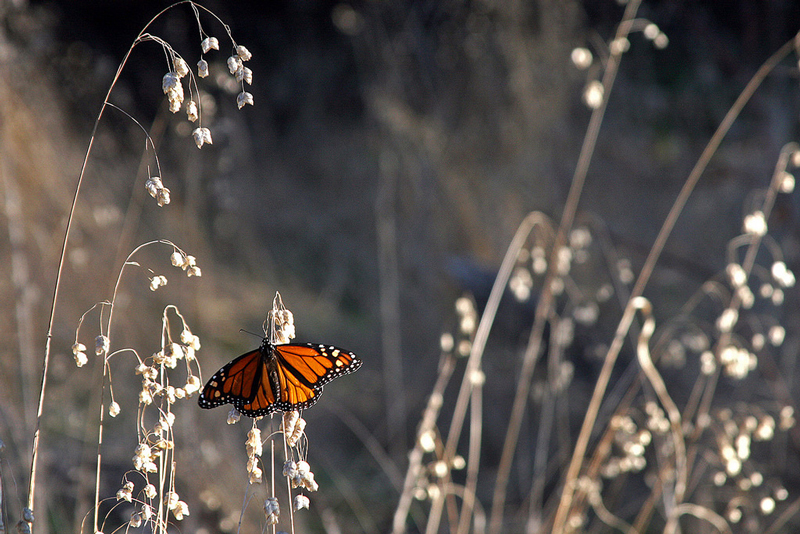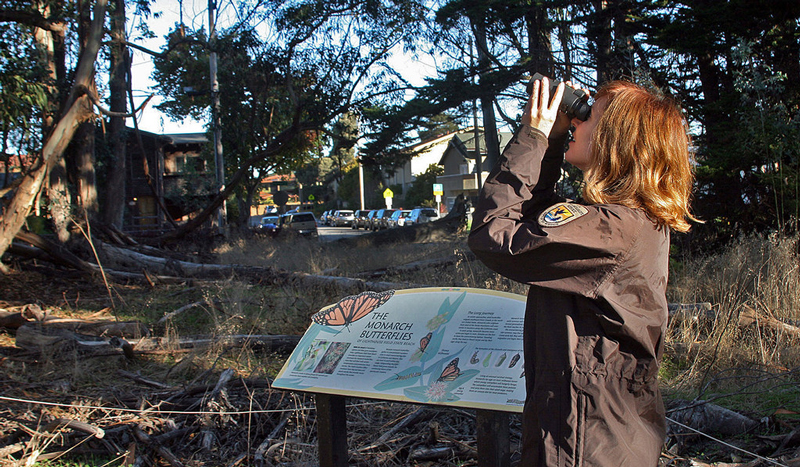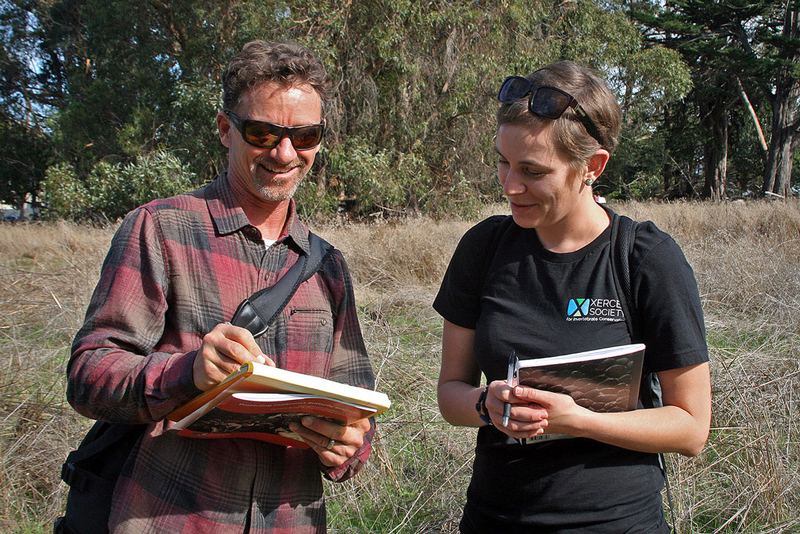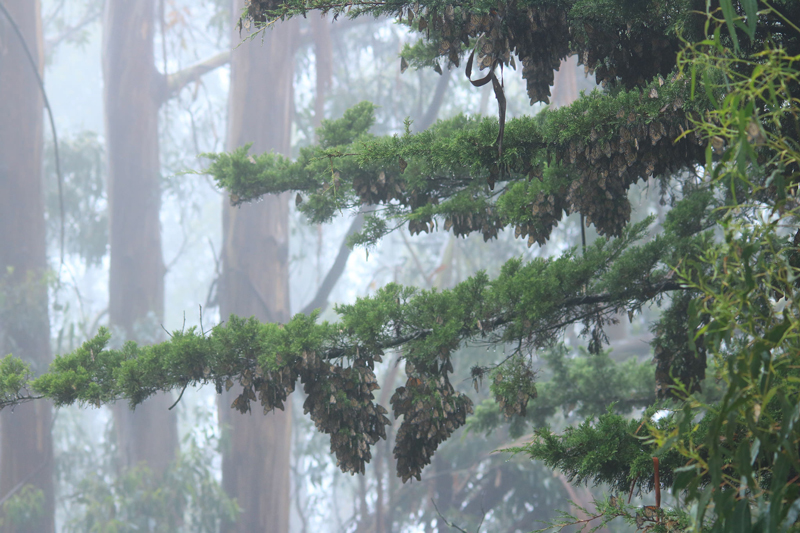The Xerces Society for Invertebrate Conservation, Groundswell Coastal Ecology, California Department of Parks and Recreation, and the U.S. Fish and Wildlife Service have developed a western monarch butterfly overwintering site management plan that also serves as a template for land managers at other overwintering sites.
The Monarch Butterfly Overwintering Site Management Plan for Lighthouse Field State Beach, presented earlier this month at the Monarch Overwintering Site Management Workshop in Oceano, California, was developed for the overwintering site at Lighthouse Field State Beach in Santa Cruz, California. Although the plan focuses on a specific site, it is adaptable to other western monarch overwintering sites along the California coast.
“Protecting and managing these groves is crucial for the continued migration of monarchs to coastal California and by extension, a great portion of the monarchs in the western U.S.,” said Emma Pelton, a conservation biologist with the Xerces Society.

The development of the Lighthouse Field site management plan began a couple of years ago when Samantha Marcum, the monarch butterfly conservation coordinator for the Pacific Southwest Region of the USFWS, and Bill Henry, director of Groundswell Coastal Ecology shared adjacent workspaces in Santa Cruz. Both had heard one another discuss current work projects; for Marcum it was management plans for western monarch overwintering sites; Henry was focused on coastal habitat restoration.
“He was located in the same office as me at the time, and he had a history of working with [California] State Parks here in Santa Cruz on coastal habitat restoration projects,” said Marcum. “So we started brainstorming how we might be able to collaborate to benefit monarchs.”
The Service had previously worked with The Xerces Society to provide support for a western monarch overwintering site status report and overwintering site management plan at a different location. Marcum approached the Xerces Society about the idea for a customizable template based on the Lighthouse Field overwintering site.
According to Marcum, Lighthouse Field was chosen for a variety of reasons: monarchs consistently return there to overwinter year-after-year, and the site had existing committed partners in Groundswell and California Department of Parks and Recreation, both of which were willing to help develop and implement the plan. The site is also ranked in the top 10 priority overwintering sites according to the Xerces Society's report State of the Monarch Butterfly Overwintering Sites in California.

“One of the big reasons I think that we’ve been able to progress in developing the plan and to be moving towards implementation is that we have a really strong partnership of people that are working together, and I think that is key for any plan to be successful,” said Marcum.
Together they began on-the-ground research, consultation with local experts, and data and literature analyses to create a management plan for California Department of Parks and Recreation to begin management actions to support overwintering monarchs at Lighthouse Field.
“Xerces worked closely with Groundswell, the U.S. Fish and Wildlife Service, and [California] State Parks to develop the plan. The team also engaged local biologists who knew the site and the monarchs well, to get a longer-term perspective,” said Pelton. “I think this multi-partner approach helps get more people together discussing management, helps identify differences in management approaches, and develop a plan that works for everyone… and represents a good model for other sites as many sites have multiple stakeholders, managers, public uses, etc.”
The plan outlines best practices for habitat management specific to maintaining or restoring microclimatic conditions within a grove that provides protection, nectar and water sources for the butterflies. This includes tree selection, placement and management to guard against winds and storms, provide the right combination of sunlight and humidity required of overwintering western monarchs, while at the same time maintaining best silvicultural, or forestry, practices to promote a healthy grove of trees.
According to Henry, consultation with an arborist was added to the plan in order to appropriately answer the questions of “How can we maintain a grove of trees so they live a long time; how do we manage [the grove] to retain desired elements beneficial to monarchs that will persist, such as allowing sunlight to penetrate some portions of the grove and maintaining protection from wind in others; how do we protect the trees from pathogenic fungi, pests, and other diseases?”

The plan also outlines suggested public outreach and engagement activities, monarch mortality monitoring, and data collection that can be used to inform other research about western monarch migration and overwintering habits.
Monarch butterflies in western North America typically arrive at overwintering sites along the California coast in September or October, and remain through early spring. These overwintering sites offer the microclimatic conditions monarch butterflies need to survive winter in western North America.
Overwintering sites along the western U.S. coast are found from Mendocino County, California to Baja California, Mexico. In recent years, many sites have become unsuitable due to multiple factors including, habitat degradation, development, and aging trees. As a result overwintering population numbers have declined by more than 95 percent in the last 30 years.

The team is hopeful that other land managers will find ways to incorporate the plan into their management practices, thereby restoring habitat crucial to western monarch butterfly survival and recovery.
“Migratory species… they’re species that move long distances and are exposed to many threats, and they say something about the general state of landscape at a large scale because they integrate space so well,” said Henry. “By protecting and maintaining healthy populations of monarchs that says that you’re maintaining healthy ecosystems across a large area and I think that that is really important.”
Funding for the research, development and implementation of the Monarch Butterfly Overwintering Site Management Plan for Lighthouse Field State Beach comes from the U.S. Fish and Wildlife Service Coastal Program, the National Fish and Wildlife Foundation and grants secured by Groundswell Coastal Ecology.
Further Reading
Learn more about our work to conserve western monarchs.
Learn more about the Xerces Society's North America-wide monarch conservation work.



